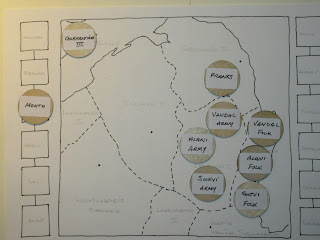In January of 407, the
barbarian horde had crossed the Rhine sending Roman-Gaul into a panic. This not
only included the armies of the Vandal, Alan and Suevi but the civilians of each
nation. Following the campaign rules, further movement would have to be
generated from building activity points during each player’s turn. Both sides focused
on the task ahead for the months of January and February.
Anxious to contain the
invasion, the Franks seized the opportunity to launch an attack against the
Vandals still occupying Germania I. The two armies, with nearly identical composition
[1], met near the foothills of the Vosges Mountains. Holding the advantage of
terrain, the Franks attacked the heavy Vandal columns. The battle was brief
with the Franks drawing off leaving the Vandals to hold the battlefield.
In March, leaving their civilians
behind in Germania I, the vanguard of each barbarian horde moved deeper into
Roman territory to plunder Belgica I. In that same month, Constantine III and
the army of Britannia landed in northern Gallia.
Constantine III having declared himself emperor
spent the summer securing his position in Gaul by building his resources (points)
and coordinating plans with the Franks to attack the barbarians. The brief
respite brought gains for Constantine III and by the end of the summer he would
be ready to march. Leaders among the barbarians were experiencing difficulties
in coordinating priorities and they too could feel an attack was imminent.
That attack came in August
with the Franks launching their second attack on the Vandals. Aided by a
contingent of Roman troops [2], the Franks caught the Vandals off balance. The
Vandal army acquitted themselves well and forced the Romano-Franks off the
field, but at a heavy cost to themselves (4 – 3).
September saw the invaders
moving their family and their belongings to Belgica I leaving Germania I a barren
wasteland. Constantine III, unperturbed by the Frankish defeat, caught the same
Vandal horde in the Loire valley and with superior numbers, including a
contingent of Franks; the Romano-Franks handily beat the barbarians. This was
the first defeat for the Vandals, but a major setback as it reduced the overall
effectiveness of its army to half strength.
The months of October and
November, Roman troops harried the barbarian foragers placing them in critical
supply (no activity points were won [3]).
December, winter quarters for
the Roman and Frankish armies.
[1] The Vandal commander’s
element was the only mounted unit for the battle.
[2] Roman and Frankish commands could supply each
other with a contingent of three elements.
[3] The only activity points won by the barbarian
player were used to move all his counters to the adjacent province, therefore
replacing battle casualties was not possible.
Assessment
The barbarian player having
brought all of his counters out of Germania I and relocating them further west
secured him a technical win. The Vandals have been seriously weakened leaving a
good many tribal leaders demanding a new king.
The Roman player took
advantage of the summer period to build a good reserve of activity points and these
will be carried over to the next scenario. Focusing on one of the barbarian
horde and not all three was smart. Next year Honorius would certainly send
Stilicho with an army and Constantine III would need a veteran force for that
fight.




No comments:
Post a Comment